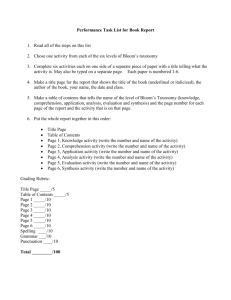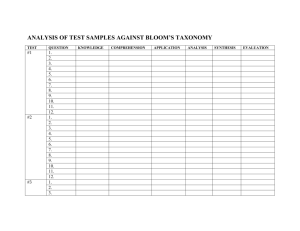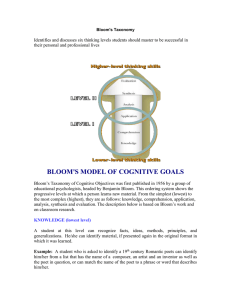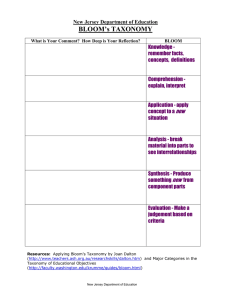The unfortuate consequences of Bloom`s taxonomy
advertisement
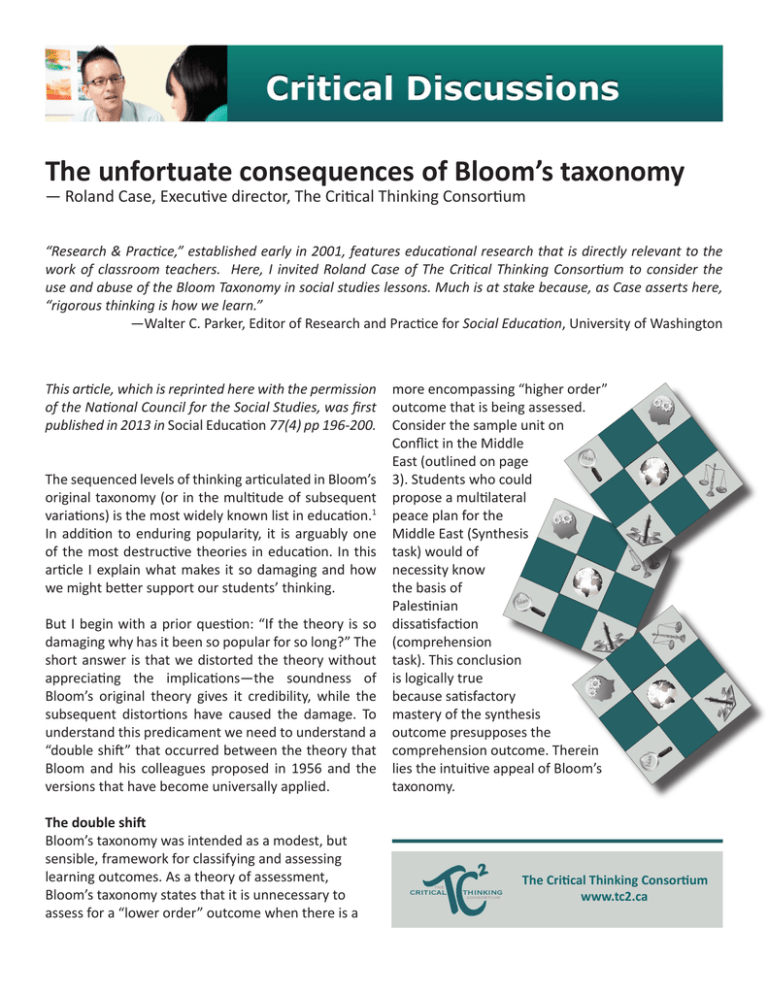
The unfortuate consequences of Bloom’s taxonomy — Roland Case, Executive director, The Critical Thinking Consortium This article, which is reprinted here with the permission of the National Council for the Social Studies, was first published in 2013 in Social Education 77(4) pp 196-200. The sequenced levels of thinking articulated in Bloom’s original taxonomy (or in the multitude of subsequent variations) is the most widely known list in education.1 In addition to enduring popularity, it is arguably one of the most destructive theories in education. In this article I explain what makes it so damaging and how we might better support our students’ thinking. But I begin with a prior question: “If the theory is so damaging why has it been so popular for so long?” The short answer is that we distorted the theory without appreciating the implications—the soundness of Bloom’s original theory gives it credibility, while the subsequent distortions have caused the damage. To understand this predicament we need to understand a “double shift” that occurred between the theory that Bloom and his colleagues proposed in 1956 and the versions that have become universally applied. The double shift Bloom’s taxonomy was intended as a modest, but sensible, framework for classifying and assessing learning outcomes. As a theory of assessment, Bloom’s taxonomy states that it is unnecessary to assess for a “lower order” outcome when there is a more encompassing “higher order” outcome that is being assessed. Consider the sample unit on Conflict in the Middle bias East (outlined on page 3). Students who could propose a multilateral peace plan for the Middle East (Synthesis task) would of necessity know the basis of bias Palestinian dissatisfaction (comprehension task). This conclusion is logically true because satisfactory mastery of the synthesis outcome presupposes the comprehension outcome. Therein lies the intuitive appeal of Bloom’s taxonomy. the critical thinking consortium bias “Research & Practice,” established early in 2001, features educational research that is directly relevant to the work of classroom teachers. Here, I invited Roland Case of The Critical Thinking Consortium to consider the use and abuse of the Bloom Taxonomy in social studies lessons. Much is at stake because, as Case asserts here, “rigorous thinking is how we learn.” —Walter C. Parker, Editor of Research and Practice for Social Education, University of Washington The Critical Thinking Consortium www.tc2.ca Bloom’s taxonomy of educational objectives Evaluation Creating Synthesis Evaluating Analysis Analyzing Applicationing Applying Comprehension Understanding Knowlegde Remembering Original version by Bloom and others (1956) A popular revised version by Anderson and others (2001)2 From assessment to teaching: However, the theory didn’t become widespread among public school educators as a theory of assessment, it became popularized as a theory of teaching—prescribing when and how outcomes should be addressed. More specifically, it came to be interpreted to preclude introducing “higher order” tasks before the “lower order” tasks had been mastered.3 In other words, the original assessment theory would suggest that if someone saw me riding a two-wheel bicycle that person can confidently assume I am also able to ride a tricycle and a four-wheel trainer. The transition to a theory of teaching now implied that I must learn the subsumed tasks before learning the more complex task. In other words, I must learn to ride a tricycle and a trainer before trying to ride a two-wheeler. While both may potentially be helpful, they are not necessary. Similarly, front-end loading information may be useful but is it logically necessary to do so before inviting “higher order” thinking? In the Middle East example, couldn’t we provide briefing sheets on Palestinian dissatisfaction that students would consult as they formulate their plan? In other words, must students master the comprehension objective prior to tackling the synthesis objective? topic”. In other words, the tasks should subsume or encompass each other as we proceed up the hierarchy. Over the years, educators broadened its use so that any “lower order” task on a topic was to be presented before any “higher order” task on the same general topic—but the tasks need not be tightly aligned. Without realizing it, we started to sequence tasks merely because of their level on the hierarchy. Consider three tasks recommended in the Middle East unit: Analysis: Compare the United Nations’ proposals to Palestinian demands. Application: How has the continued conflict impacted the residents of this region? Knowledge: Recall the reasons establishment of the state of Israel. for the In this instance, even Bloom’s theory of assessment would not apply. Being able to compare the UN proposals with Palestinian demands (analysis) does not imply an ability to identify the impact on residents (application), and neither presuppose an ability to recall reasons for the state of Israel (knowledge). Although the topic is broadly similar (Middle East conflict), the From tightly to loosely aligned: Concurrent with this focus of each task is not tightly aligned. Assessing shift from assessment to teaching is a second move: students’ ability to complete the “higher order” tasks Bloom’s original theory applies only if the levels of does not logically imply that students have mastered objectives focus on what I will call a “tightly aligned the “lower order” task. 2 The Critical Thinking Consortium Conflict in the Middle East4 Levels in Bloom’s taxonomy Outcomes Knowledge Identify who are the Palestinians. Recall the reasons for the establishment of the state of Israel. Comprehension Explain why the Palestinians are dissatisfied with Israeli rule. Application How has the continued conflict impacted the residents of this region? Analysis Compare the United Nations’ proposals to Palestinian demands. Synthesis Propose a plan to address all sides to the conflict. Evaluation Defend one perspective toward use and access of holy places in Jerusalem. The move from tightly to loosely aligned topics is troubling when we treat the taxonomy as a theory of teaching. There is now even less reason to begin with Knowledge outcomes since this information may be irrelevant to preparing students for the Analysis outcome. Yet, according to the expanded interpretation of Bloom, because Knowledge outcomes involve “lower order” tasks, their mastery must precede efforts to engage students in “higher order” tasks within the unit. This is seen to be required even if analyzing the UN proposals was actually an easier task than determining the impact of the conflict. that mainstream or at risk students who struggled with Knowledge and Comprehension shouldn’t be taxed with “higher order” tasks. In one alarming example, a curriculum document for an “applied” history course replaced the “higher order” verbs found in the mainstream curriculum with “lower order” verbs. Thus, instead of being asked to assess, synthesize, and apply, students in the applied course were asked merely to list, summarize, and recall.6 The irony is that instead of encouraging teachers to invite students to think, the effect has been to provide teachers with a reason to expect little rigorous thinking from many students. Educators had now moved away from a theory of assessment that allowed us to deduce the more specific outcomes that students logically would have met based on an assessment of a more complex but encompassing task. Instead, the theory was seen to offer a general rule for sequencing tasks based on their level of complexity—even if the tasks did not overlap and the “higher order” tasks were not more difficult to complete than their “lower order” counterparts.5 Source of the misapplication: The rationale for reduced student expectations is grounded in a misleading assumption that so called “higher order” thinking tasks are inherently more difficult than “lower order” tasks. Certainly, we can agree that students who struggle to comprehend a set of facts will likely have trouble with a tightly aligned “higher order” question that subsumes those facts. But it would be unfounded to conclude that students couldn’t complete a simpler version of the “higher order” task that placed less demands on the amount and complexity of the facts they needed to know. We can appreciate this point by comparing an easy and demanding version of the previously discussed Synthesis task: As suggested by the title of this article, my aim is to expose the unfortunate consequences resulting from distortions to Bloom’s theory—not his original formulation. I will explore three flaws, explain the source of each, and suggest a better way forward. Flaw #1: Lowers expectations for thinking The problem: The misapplication of Bloom’s taxonomy as a theory of teaching is often used to justify reduced expectations about students’ capacity to think. We see this evident in teacher comments such as: “My students struggle with comprehension and recall, how can I expect them to tackle application and evaluation?” In a similar vein, critical thinking was often reserved for gifted classes because it was presumed • Easy version: Propose a plausible recommendation dealing with a simple aspect of the Middle East conflict that would accommodate the interests of at least two affected groups. • Demanding version: Propose a comprehensive plan dealing with all aspects of the conflict that would address all sides, including the major factions in the area and the outside powers with interests in the region. The Critical Thinking Consortium 3 Although both tasks involve synthesis their degree of difficulty varies greatly. Many students could likely offer a plausible response to the easy version without completely satisfying the comprehension task (Explain the basis of Palestinian dissatisfaction with Israeli rule). If the easy task was still too demanding, we could formulate a simpler version: Which of the two suggested recommendations better accommodates the interests of both affected groups? (evaluation). We might also differentiate the recommendations to be reviewed— presenting challenging pairs of recommendations to some students and straightforward recommendations to others. Providing additional support would further bring the task within students’ “zone of proximal development.” For example, we might present students with a simple chart summarizing the implications of each recommendation for each group. The general point to appreciate is that the degree of difficulty of any “higher order” task can be greatly lessened to bring it within the reach of almost all students. invitation to analyze parts, synthesize diverse sources, or apply in novel situations? The notion that we can’t really understand something if we haven’t “digested” or worked with the idea lies at the heart of a constructive view of learning. As Resnick explains, “learning occurs not by recording of information but by interpreting it. . . . The traditional view of instruction as direct transfer of knowledge does not fit this constructivist perspective.”7 Or to use Gardner’s phrase, “coverage is the enemy of understanding.”8 For these reasons, critics see it as a misrepresentation to characterize understanding as a form of “lower order” thinking since it doesn’t emerge from low level or transmissive learning activities. To highlight this point, some recommend flipping the taxonomy on its head by placing “understanding” at the apex of learning.9 The effect of an impoverished conception of understanding is to encourage a transmissive approach A better way forward: Rather than presume that to content knowledge—that is, to encourage teachers “higher order” tasks will always be more difficult than to teach subject matter through direct transfer of “lower order” tasks, teachers can tweak almost any information to the student. Not only is this not effective, level of question by reducing its difficulty (but not in most courses there is so much content to “cover” its level) and simultaneously increasing the support that a transmissive approach typically leaves little or no offered to students. It is true that we have in one time for meaningful opportunities for “higher order” respect lowered our expectations, but we have done so thinking. Paradoxically, a theory whose intention was in an importantly different way: we are differentiating to promote more thinking has had the opposite effect the difficulty of the “higher order” tasks we expect of by encouraging teachers to teach the core course students, not eliminating “higher order” tasks from content without requiring rigorous thinking. our expectations. Source of the misapplication: Bloom’s taxonomy as Flaw #2 Encourages transmission of information a theory of teaching is seen to suggest that “lower The problem: A widely held misconception of Bloom’s order” outcomes are learned/taught through “lower taxonomy is that it is seen to prescribe a necessary order” activities, and “higher order” outcomes are pathway for learning that requires moving up the learned/taught through “high order” activities. hierarchy: Teachers are to begin by front-end loading Certainly if I understand something I will be able to information acquired through “lower order” tasks show comprehension by giving examples or offering a before engaging students in more complex tasks. For definition (Bloom’s theory of assessment), but I will not example, when promoting comprehension outcomes, be able to develop comprehension in the first place if teachers are directed to invite student to “describe,” these are my learning tasks. The presumption that we “express,” “locate,” “explain,” or “summarize” the should acquire and demonstrate outcomes in the same information. Or to put it another way, students are way fails to acknowledge the implications of shifting expected to understand material without be asked to from assessment to teaching. “interpret,” “distinguish,” “relate” or “question” the subject matter. Consider, for example, the differing implications for teaching when the intended assessment outcome But what does it mean to “explain” if there is no goes from “understanding the importance of the main 4 The Critical Thinking Consortium causes of WWII” (comprehension) to “assessing the importance of the main causes of WWII” (evaluation). An end-of-unit assessment task for the evaluation outcome might be: Rank order the main causes of WWII based on an assessment of their importance. But the teacher should not have used this task as a learning activity during the unit; otherwise her students could simply remember the rankings and reasons discussed in class (making it a comprehension outcome). Instead she may have prepared students by providing background information on the various causes of the war. On the other hand, if the intended outcome was understanding the importance, she could have used the ranking task as a learning activity to help students make sense of the various causes. For example, students might have read the background information provided by the teacher and did the ranking as an inclass learning activity. The end-of-unit assessment of the comprehension outcome might be: Discuss in your own words the relative importance of the main causes of WWII. In this case, the teacher is assessing what student had been able to glean from the ranking task done during the unit. This example illustrates how “lower order“ assessment outcomes don’t necessarily equate with “lower order“ learning tasks. In fact, we are left with counterintuitive conclusions about Bloom’s Taxonomy as a theory of pedagogy: So-called “lower order” outcomes may best be taught through “higher order” activities, and “higher order” outcomes may be nurtured using “lower order” activities. A better way forward: Rather than presume that only “higher order” outcomes require “higher order” learning tasks, let’s recognize that rigorous thinking is how we learn. Transmitting information and providing definitions don’t develop factual and conceptual understanding. This is more likely to develop by problematizing the content using “higher order” learning tasks so that students are engaged in digesting the material.10 Flaw #3: Creates false confidence The problem: A final concern is the misplaced confidence created by the taxonomy that we are doing more than we are to promote robust thinking. Bloom carefully attached verbs to each of the levels of cognition. Over time many have come to believe that the mere use of a specified verb is sufficient to evoke a particular kind of “higher order” thinking. For example, the verb “defend” in the following outcome from the Middle East unit is assumed to require evaluative thinking: Defend one perspective toward use and access of holy places in Jerusalem. But is this necessarily the case? Imagine the following hypothetical explanation of how a student approached the task: “I picked the position that made sense to me (or that I thought the teacher preferred). Then I found or made up reasons to support that position.” In this scenario, there is virtually no evaluative thinking. It is what Bloom himself would call mere opinion: “For the most part, the evaluations customarily made by an individual are quick decisions not preceded by very careful consideration of the various aspects of the object, idea or activity being judged. These might be termed opinions rather than judgments . . . For purposes of classification [at the highest level of the taxonomy], only those evaluations which are or can be made with distinct criteria in mind are considered.”11 The student in this hypothetical but not fanciful scenario has rationalized, not justified, her position. The mere action of “defending” does not necessarily imply evaluative (critical) thinking. The potential for hollow answers is there for any of the verbs at any level whenever an evaluative dimension is missing. For example, imagine the following answer to the request to compare the United Nations’ proposals to Palestinian demands (analysis). After reading relevant documents, a student offers the following comparisons: • The UN proposals were proposed by people employed by the UN; the Palestine demands were not. • Both involve the Middle East conflict. • Both include suggestions for improvement. • There are over 50 hard-to-understand words in the UN proposals. Although the student’s statements may be true, they contain no real analysis of the relative positions. In effect, he has merely located information from the The Critical Thinking Consortium 5 relevant documents. Despite the verb, there is no evidence of thoughtful analysis because his answers show no consideration of the criteria for a sensible or appropriate comparison. He has not judged whether his observations are relevant to the purpose, representative of the documents, or illuminating (non trivial). Students can go through the motions of comparing (or spewing forth reasons) but unless this is done in the face of conscious consideration of relevant criteria for the task, the exercise hardly warrants the term “higher order.“ Unfortunately, the selective use of verbs to trigger thoughtful student responses often falls short of their intended purpose when the use of any evaluative terms are restricted to only one level of thinking. expectations for reasoned judgments where students know to assess or judge the merits of available options in light of relevant factors or criteria. For example, “Explaining” should not be seen as a mechanical task, but rather as one that requires thoughtful choices about what to say and how to say it, and is informed by the purpose, audience, and content to be explained. A similar point can be made about any intellectual task at any level in the taxonomy. In the chart below I have rewritten the questions from the Middle East unit to more explicitly invite the kind of critical reflection required for every level of thinking. Conclusion The paradox of popular interpretations of Bloom’s Taxonomy is that efforts to elevate the quality and Source of the misapplication: The presumption that complexity of classroom tasks have often had the the verb clearly determines the kind of thinking that opposite effect. As an alternative, I have suggested students actually perform fails to recognize that tasks at three principles to effectively promote thinking: every level can be done in one of two ways— “critically • Adjust the difficulty so that every student thoughtfully” or “critically thoughtlessly”—and the engages regularly in “higher order” learning difference depends on the making of reasoned or activities. evaluative judgments arrived by consideration of the relevant criteria for the task. Or to put it another way, • Appreciate that understanding of subject evaluation is not one level of thinking divorced from matter is not a “lower order” task that can be other levels: All rigorous thinking has an evaluative transmitted; it requires that students think dimension. But terms such as “assess,” “appraise” critically with and about the ideas. and “judge” are not part of the language of analysis, application and synthesis—they are the exclusive • Understand that inviting students to offer domain of evaluation. reasoned judgments is a more fruitful way of framing learning tasks than is the use of verbs A better way forward: Since all rigorous thinking is clustered around levels of thinking that are evaluative (critical) thinking, it is important to establish removed from evaluative judgments. Levels in Bloom’s taxonomy Critically thoughtful tasks Knowledge Identify the four most important things to remember about who are the Palestinians. Comprehension In a clear manner that is accessible to your peers, explain three important reasons why the Palestinians are dissatisfied with Israeli rule. Application Deduce by carefully inferring from the data and documents supplied how the continued conflict has impacted the residents of this region. Analysis Identify the most significant similarities and differences between the United Nations’ proposals and Palestinian demands. Synthesis Propose a plan to address all sides to the conflict that is comprehensive, fair, feasible and effective. Evaluation Defend/assess with reference to fairness, sustainability and effectiveness one perspective toward use and access of holy places in Jerusalem. 6 The Critical Thinking Consortium Notes: 1. Lee S. Shulman, “Making Differences: A Table of Learning” Change: The Magazine of Higher Learning 34, no. 6 (2002): 36–44. As of 2002, it had been translated into 22 languages; see David R. Krathwohl, “A Revision of Bloom’s Taxonomy: An Overview,” Theory into Practice 41 no. 4 (2002): 213. 2. The original version was presented in Benjamin S. Bloom et al., Taxonomy of Educational Objectives: The Classification of Educational Goals, by a Committee of College and University Examiners. Handbook 1: Cognitive Domain (New York: David McKay, 1956). The most famous revision is found in A Taxonomy for Learning, Teaching and Assessing: A Revision of Bloom’s Taxonomy of Educational Objectives, complete edition, eds. L.W. Anderson and David R. Krathwohl (New York: Longman, 2001). 3. Andrew Churches, “Bloom’s Digital Technology” n.d. retrieved March 9, 2013 (p. 5). www.techlearning.com/techlearning/ archives/2008/04/AndrewChurches.pdf. 4. This unit overview is posted in “Bloom’s Taxonomy for Social Studies: Levels of Questioning,” Edmond Public Schools, Oklahoma, n.d. retrieved March 9, 2013 www.edmondschools.net/Portals/0/docs/Bloom%27sTaxonomy.pdf. 5. I want to acknowledge that not all educators use the theory in these ways: some employ it solely as a convenient way to diversify the tasks they ask of students, and to remind themselves to go beyond a reliance on factual questions. But as I will explain, even this use has significant drawbacks. 6. Fabrizio Antonelli, From Applied to Applause (Toronto: Ontario Secondary Teachers’ Federation, 2004), 38. Available online. 7. Lauren B. Resnick, “Introduction,” Knowing, Learning, and Instruction: Essays in Honor of Robert Glaser, ed. L.B. Resnick (Hillsdale, N.J.: Erlbaum, 1989), 2. 8. Cited in Antonelli, From Applied to Applause, 42. 9. See Sam Wineburg and Jack Schneider, “Was Bloom’s Taxonomy Pointed in the Wrong Direction?” Phi Delta Kappan 91, no. 4 (2010), 56–61. 10. Our work at The Critical Thinking Consortium, www.tc2.ca, is dedicated to teaching all learning outcomes by thinking critically with and about the content. For discussions of these points and teaching ideas see The Anthology of Social Studies: Issue and Strategies for Secondary Teachers, eds. Roland Case and Penney Clark (Vancouver: Pacific Educational Press, 2008). In particular, see Roland Case, “Beyond Inert Facts: Teaching for Understanding in Secondary Social Studies,” 41–53; and John Myers and Roland Case, “Beyond Mere Definition: Teaching for Conceptual Understanding in Secondary Social Studies,” 54–65, 186. 11. Bloom et al. Taxonomy of Educational Objectives, 186.
